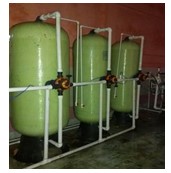Demineralization of water (DM Plant)
What is Demineralizer?
A demineralizer is a system, which uses an ion exchange chemical process to remove dissolved ionic compounds (salts) from water. It is also known as Deionized Water System, Demineralizer, or DM Plant. A typical Demineralization Plant (DM Plant) consists of two vessels. The feed water or raw water is passed through the first vessel i.e. containing strong base cation resin in the form of Hydrogen (H+), whereupon all the positively charged ions (sodium, calcium, iron, copper, etc.) are exchanged for Hydrogen ions; after that, the water further passed through another vessel containing strong base anion resin in the form of Hydroxyl (OH-), whereupon all the negatively charged ions (chloride, sulfate, nitrate, etc.) are exchanged for hydroxide ions which then combine with the hydrogen ions to form water.
Types Of Demineralizers
Two-bed Demineralizer
Mixed bed Demineralizer
Demineralizer Configurations
Potable water Demineralizer
Packaged DM water Plant
DM Plant Regeneration
Depending upon the frequency of use and DI Water output, the resin becomes exhausted and does not capable to deionize; in other words, their power of removing ionic materials reduces and active ion concentration reaches a low level. The process of restoring their power or enhancing active ion concentration level is called regeneration. In this process exhausted cation and anion ions are recharged with Hydrogen (H) Hydroxyl (OH) ions.

Demineralizer Applications
| – Paint Factory – Chemical Processing – Glassware rinse – Textiles Mills – Plating – Electrodeposition – Cosmetics Production | – Printing – Glass/Mirror – Boiler feed – Cooling Tower – Vehicle wash – Film processing – Ice plants | – Horticulture / Greenhouse – Food / Beverage processing – Electronics Manufacturing – Testing and materials – Research and development – Hospitals / Medical facilities – Metalworking lubricants |
Two Bed Demineralizer
Often called Dual Bed, Two Bed Demineralizers have the cation resin and anion resin in separate vessels. They can be regenerated is series (cation followed by anion); or in parallel (cation and anion simultaneously). Anion resin must have the hardness removed from the influent water to prevent hardness fouling. The cation resin is regenerated with acid (hydrochloric or sulfuric) and the anion resin is regenerated with sodium hydroxide (caustic soda).
Two Bed Demineralizers normally produce water quality in the range of 50,000 ohms up to 200,000 ohms’ resistivity, which is between 8.5 and 2.0 ppm TDS as CaCO3. Automatically mixed deionizers utilize the same resins but mix the two resins for use. This produces a significantly higher purity than two-column design, up to 18 megohms.
Mixed Bed DM Plant
Mixed Bed DM Plant is a single vessel unit, which combines Cation and Anion exchangers in a single column. When it comes to requiring high-purity Demineralized Water, a mixed bed demineralizer is considered more efficient in many ways. It is used as a polishing unit to purify water to higher levels, which is treated through a Two Bed demineralized or Reverse Osmosis Unit at an earlier stage. At Bionics Consortium Pvt. Ltd., we manufacture mixed bed demineralizer plant up 50 m3/h with manual or automatic regeneration facility as required.
Industry-Specific DM Plant
Moon Mine manufactures DM Plant units for industrial and commercial applications with full-service installation and commissioning services throughout India and overseas at a very competitive price. Designed ergonomically, these units can be constructed up to 50 m3/h or more flow rate capacities. We manufacture both dual bed DM plant and mixed bed DM plant depending upon the end-use of demineralized water. Manufactured by our engineering team, our DM Plants are successfully working in various industrial sectors such as pharmaceutical, textile, Thermal Power Plants, laboratory, dialysis, car wash, etc. These water treatment systems are custom built and constructed according to customer-provided specifications with the availability of a wide range of options and related equipment, meeting specific application requirements and quality standards.
DM Plant Specifications
| Flow rates | Up to 50m3/h or more |
| Configuration | Dual Bed or Mixed Bed |
| Vessel | FRP / MS / MSRL |
| Vessel size | 18” to 48” in diameter |
| Operation | Manual or Fully and semi-automatic |
| Pipe Size | 1’’ to 3’’ |
| Optional | – ASME code vessels – Skid mounted unit – Degasser Tower |
| Installation | Covered or open |
